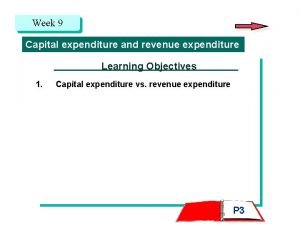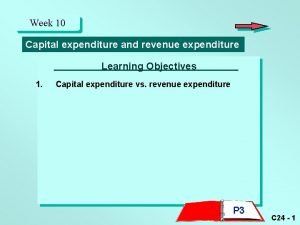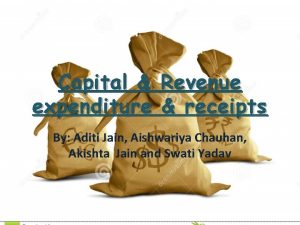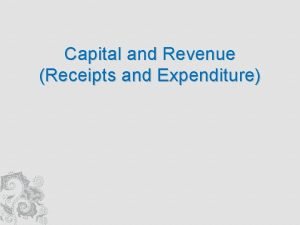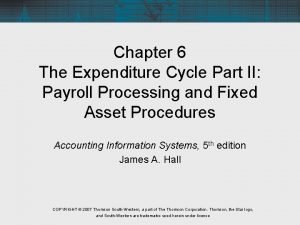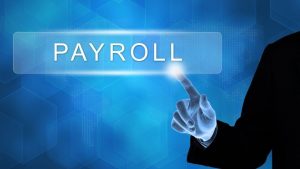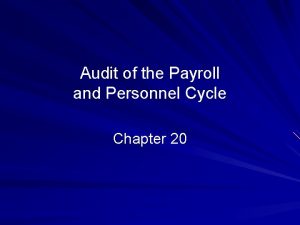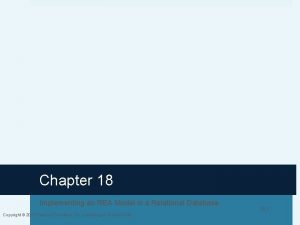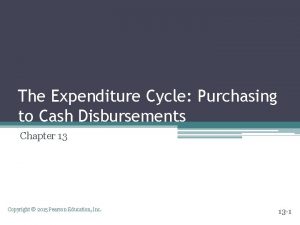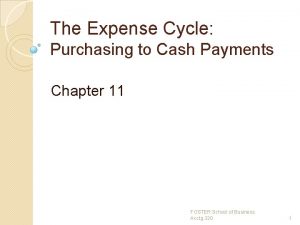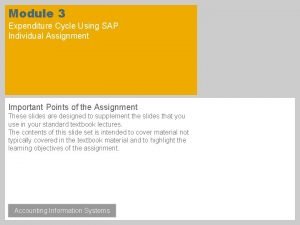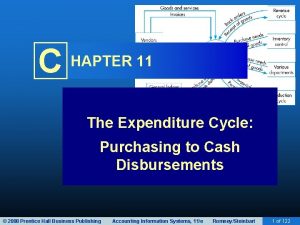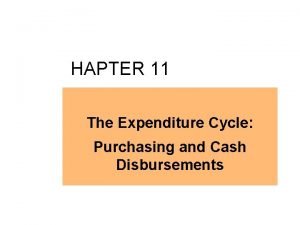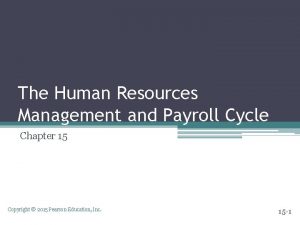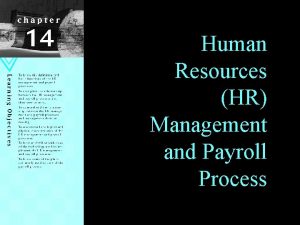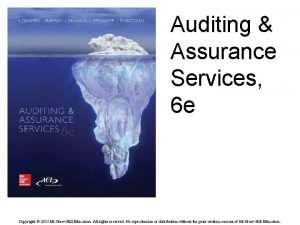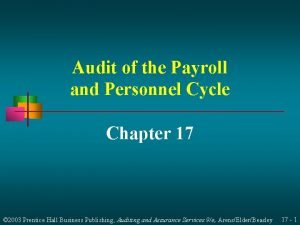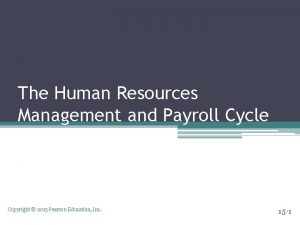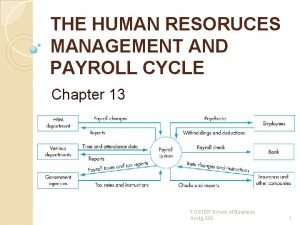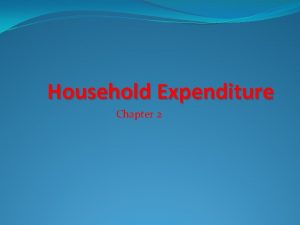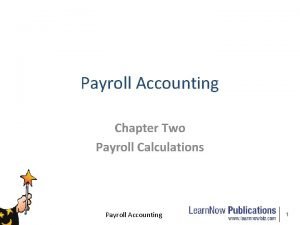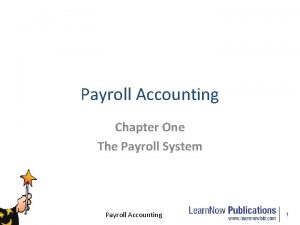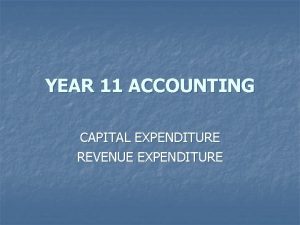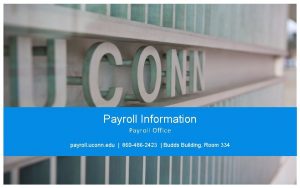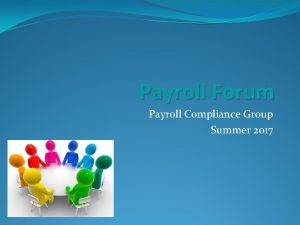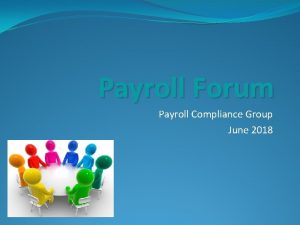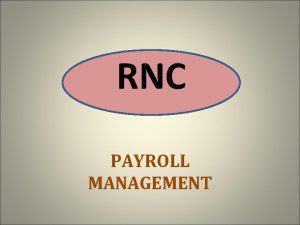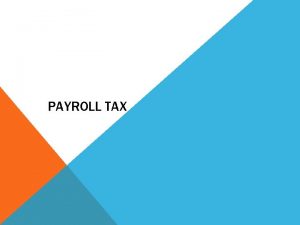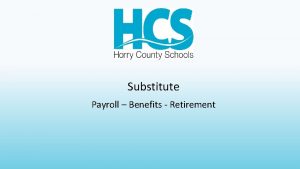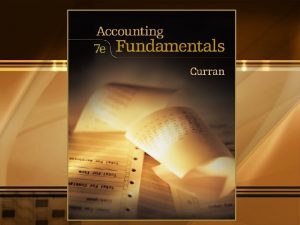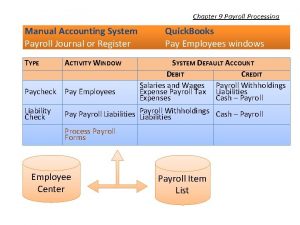Chapter 6 The Expenditure Cycle Part II Payroll



































- Slides: 35

Chapter 6 The Expenditure Cycle Part II: Payroll Processing and Fixed Asset Procedures

Objectives for Chapter 6 • Fundamental tasks of the payroll and fixed asset processes • Functional departments of payroll and fixed asset activities and the flow of transactions through the organization • Documents, journals, and accounts that provide audit trails, promote the maintenance of records, and support decision making and financial reporting • Exposures associated with payroll and fixed asset activities and the controls that reduce these risks • Operational features and the control implications of technology used in payroll and fixed asset systems

DFD of Payroll Procedures

Manual Payroll System • The Personnel department uses personnel action forms to: – activate new employees – change the pay rate of employees – change marital status and/or number of dependents – terminate employees

Manual Payroll System • The production employees fill out two forms: – job tickets - account for the time spent by the individual worker on each production job – time cards - used to capture the total time worked each pay period for payroll calculations; must be signed by a supervisor

Manual Payroll System • The Cost Accounting department: – uses the job tickets to allocate labor costs to WIP accounts – summarizes these charges in a labor distribution summary which is forwarded to the General Ledger department

Manual Payroll System • The Payroll department receives the personnel action forms and the time cards. • It uses them to perform the following tasks: – prepares the payroll register – enters the information into the employee payroll records – prepares paychecks – sends paychecks to Cash Disbursements and a copy of the payroll register to Accounts Payable

Manual Payroll System • Accounts Payable department: – prepares a cash disbursements voucher for the total amount of the payroll – sends copies to the Cash Disbursements and General Ledger departments

Manual Payroll System • Cash Disbursements reviews and signs the paychecks and forwards them to a paymaster for distribution to the employees. • Cash Disbursements writes a check for the payroll and deposits it into the payroll imprest account.

Manual Payroll System • General Ledger makes the following entries: – FROM LABOR DISTRIBUTION SUMMARY WIP (Direct Labor) DR Factory Overhead (Indirect Labor) DR Wages Payable – FROM DISTRIBUTION VOUCHER Wages Payable DR Cash Fed. Inc. Tax Withholding Payable State Inc. Tax Withholding Payable FICA Withholding Payable Other Withholding Payables CR CR CR

Manual Payroll System • Further, the General Ledger department needs to make a journal entry to transfer the cash from the operating bank account to the payroll imprest account: Cash - Payroll Imprest Account Cash - Operating Account DR CR

Payroll Controls • Transaction authorization - the personnel action form is important in preventing: – terminated employees from receiving checks – wage rates from being improperly changed for current employees

Payroll Controls • Segregation of Duties - timekeeping and personnel functions should be separated • Supervision - need to monitor employees to ensure they are not “clocking in” for one another

Payroll Controls • Accounting Records - audit trail includes: – time cards – job tickets – disbursement vouchers – labor distribution summary – payroll register – subsidiary ledger accounts – general ledger accounts

Payroll Controls • Access Controls - need to prevent employees from having improper access to: – accounting records, such as time cards which can be altered – unsigned checks

Payroll Controls • Independent Verification: – verification of time cards – distribution of paychecks to authorized employees – verification of accuracy of payroll register by accounts payable – general ledger reconciles the labor distribution summary and the payroll disbursement voucher

Computer-Based Payroll Systems • Payroll is well-suited to batch processing and sequential files, since a majority of the employees on the master file will receive a paycheck every pay period. • The computer program performs the detailed record-keeping, check-writing, and general ledger functions.

Human Resource Management (HRM) Systems • A re-engineered IT that captures and processes a wide range of personnelrelated data, including: – employee benefits – labor resource planning – employee skills – pay rates and deductions – evaluations – payroll

Key Features of HRM Systems • Personnel - can make changes to the employee file in real time • Cost Accounting - enters job cost data either daily or in real time • Timekeeping - enters the attendance file daily • Data Processing - still uses batch processing and prepares all reports, the checks, and updates the general ledger

HRM Systems… differ from automated batch, sequential file systems in the following ways: – operations depts. transmit transactions to data processing via terminals – direct access files are used for storage – many processes are performed real time – real-time access to personnel files required for direct inquiries

Reengineering Payroll • Payroll can be reengineered as a part of human resource management (HRM). • In reengineered payroll systems – operations departments transmit transactions to data processing via terminals – direct access files are used for data storage – many processes are now performed in real time.

Reengineering Payroll--Before

Reengineering Payroll--After

The Fixed Asset System (FAS) • Fixed Assets - property, plant, and equipment used in the operation of a business

Life of a Fixed Asset 1. Acquisition of asset. Asset cost $ Dec 2. Depreciation. 3. Subsequent expenditures. line in a 4. Disposal of asset. sse t ’s s erv ice Cost pot ent ial Salvage value Time (useful life)

DFD of Fixed Asset System

Objectives of the FAS • Process the acquisition of fixed assets as needed and in accordance with formal management approval and procedures • Maintain adequate accounting records of asset acquisition, cost, description, and physical location in the organization • Maintain accurate depreciation records for depreciable assets in accordance with acceptable method • Provide management with information to help it plan future fixed asset investments • Properly record the retirement and disposal of fixed assets

Asset Acquisition • Generally begins with a department manager determining that an old fixed asset needs to be replaced or the need for a new fixed asset is warranted • The manager fills out a purchase requisition and may require a signature for items over a pre-specified limit. • The fixed asset department performs the record-keeping function.

Asset Maintenance • Involves adjusting the fixed asset subsidiary account balances as the assets depreciate over time (or deplete with usage) • Depreciation calculations are internal transactions that the fixed asset system must process based upon a depreciation schedule. • Physical improvements must also be recorded to increase the subsidiary account balance and depreciation schedule.

Asset Disposal • At the end of the useful life or an earlier disposition of the asset, the asset must be removed from the records. • The disposal requires a disposal request and disposal report as source documents to remove the asset from the records and the depreciation schedules.

Computer-Based Fixed Asset System--Acquisition • Acquisition - the receipt of the asset is recorded, along with information such as its useful life, depreciation methods, etc. and the ledgers are automatically updated

Computer-Based Fixed Asset System--Maintenance • Computerized FAS will automatically: – calculate current period’s depreciation – update the accumulated depreciation and book -value fields in the subsidiary records – post the total amount of depreciation to the affected general ledger accounts • depreciation expense and accumulated depreciation – record the depreciation transaction by adding a record to the journal voucher file

Computer-Based Fixed Asset System--Disposal • Computerized FAS will automatically: – post an adjusting entry to the fixed asset control account in the general ledger – record any loss or gain associated with the disposal transaction – prepare a journal voucher record

Controlling the Fixed Asset System • Authorization should be formal and explicit because of high cost of PPE: – acquisitions – changes in depreciation methods • Supervision - threat of misappropriation requires constant management supervision: – theft--secure the physical location of assets – misuse--monitor on-the-job activities

Controlling the Fixed Asset System • Independent Verification Controls the internal auditor should periodically verify FAS records: – the reasonableness of factors used in decisions (useful life, discounts, budgeting model) – location, condition, and fair value of the fixed asset records in the subsidiary ledger – the programming logic for automatic calculations (depreciation)
 Revenue expenditure vs capital expenditure
Revenue expenditure vs capital expenditure Capital expenditure examples
Capital expenditure examples Deferred revenue expenditure
Deferred revenue expenditure Capital expenditure vs revenue expenditure
Capital expenditure vs revenue expenditure Payroll cycle flowchart
Payroll cycle flowchart Payroll tax liability journal entry
Payroll tax liability journal entry Payroll and personnel cycle
Payroll and personnel cycle Rea diagram revenue cycle
Rea diagram revenue cycle Expenditure cycle threats and controls
Expenditure cycle threats and controls The expenditure cycle
The expenditure cycle What is expenditure cycle
What is expenditure cycle Expenditure cycle steps
Expenditure cycle steps Expenditure cycle steps
Expenditure cycle steps Primary objective of expenditure cycle
Primary objective of expenditure cycle Expenditure cycle
Expenditure cycle Expenditure management cycle
Expenditure management cycle 1. 13-1 work together, p. 381
1. 13-1 work together, p. 381 Payroll cycle activities
Payroll cycle activities Payroll cycle activities
Payroll cycle activities Payroll cycle activities
Payroll cycle activities Payroll flowchart
Payroll flowchart Payroll cycle
Payroll cycle Payroll and personnel cycle
Payroll and personnel cycle Payroll cycle activities
Payroll cycle activities Payroll cycle activities
Payroll cycle activities Chapter 5 two-cycle and four-cycle engines answers
Chapter 5 two-cycle and four-cycle engines answers Hình ảnh bộ gõ cơ thể búng tay
Hình ảnh bộ gõ cơ thể búng tay Bổ thể
Bổ thể Tỉ lệ cơ thể trẻ em
Tỉ lệ cơ thể trẻ em Voi kéo gỗ như thế nào
Voi kéo gỗ như thế nào Tư thế worms-breton
Tư thế worms-breton Bài hát chúa yêu trần thế alleluia
Bài hát chúa yêu trần thế alleluia Môn thể thao bắt đầu bằng chữ f
Môn thể thao bắt đầu bằng chữ f Thế nào là hệ số cao nhất
Thế nào là hệ số cao nhất Các châu lục và đại dương trên thế giới
Các châu lục và đại dương trên thế giới
